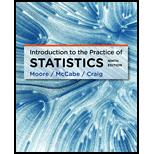
Concept explainers
(a)
To find: The comparison of two predicted mean strengths using their difference.
(a)
Answer to Problem 72E
Solution: The predicted dominant arm strength for a baseball player is
Explanation of Solution
Calculation: It is noted from the referred Exercises 2.70 and 2.71 that the predicted mean strength of the dominant arm
The difference in the two predicted mean strengths is calculated as:
Therefore, the difference in the mean strengths of a baseball and a non-baseball player is positive. This implies that the predicted dominant arm strength for a baseball player, who uses exercise strength, is greater than the predicted dominant arm strength for a baseball player, who uses control more than the exercise strength. Thus, it can be said that
(b)
To explain: The inference for the difference in the two predicted mean strengths.
(b)
Answer to Problem 72E
Solution: There is a positive impact of the baseball throwing exercise over control as the difference in the mean arm strengths of the baseball player and a non-baseball player is positive.
Explanation of Solution
(c)
Section 1
To find: The predicted dominant arm strengths for non-dominant strengths
(c)
Section 1
Answer to Problem 72E
Solution: The results obtained are represented in the following table:
Dominant arm Strength |
|||
Non-Baseball Player |
Baseball Player |
||
Non-Dominant Arm Strength |
|||
Explanation of Solution
Calculation: The linear regression equations for a non-baseball player is:
and for a baseball player is:
From the above part (a), the dominant arm strengths when the non-dominant strength is
The dominant arm strengths provided the non-dominant arm strength as
For a non-baseball player, it is represented as
For a baseball player, it is represented as
The dominant arm strengths provided the non-dominant arm strength as
For a non-baseball player, it is represented as
For a baseball player, it is represented as
The above results obtained can be represented in the form of a table as follows:
Dominant arm Strength |
|||
Non-Baseball Player |
Baseball Player |
||
Non-Dominant Arm Strength |
|||
Section 2:
To find: The differences in the respective arm strengths.
Section 2:
Answer to Problem 72E
Solution: The differences are
Explanation of Solution
Calculation: The arm strengths for the non-dominant arm strengths
Dominant arm Strength |
|||
Non-Baseball Player |
Baseball Player |
||
Non-Dominant Arm Strength |
|||
The difference in the arm strengths of baseball and the non-baseball players are calculated as follows:
For non-dominant arm strength
For non-dominant arm strength
Hence, the differences are
Section 3:
To find: A table for the results of the three calculations.
Section 3:
Answer to Problem 72E
Solution: The resultant table is obtained as follows:
Dominant arm Strength |
||||
Non-Baseball Player |
Baseball Player |
Differences |
||
Non-Dominant Arm Strength |
||||
Explanation of Solution
Also,
The differences in the estimated strengths have been calculated as:
where,
The above information can be represented in the form of a table as follows:
Dominant arm Strength |
||||
Non-Baseball Player |
Baseball Player |
Differences |
||
Non-Dominant Arm Strength |
||||
(d)
Section 1:
To explain: The summary of results obtained in part (c) of exercise 2.72.
(d)
Section 1:
Answer to Problem 72E
Solution: The results show that the baseball throwing exercise has resulted in an improvement in the dominant arm strengths of the baseball players as compared to the non-baseball players for all the three cases. That is, the difference between the two is positive for all the three cases.
Explanation of Solution
Dominant arm Strength |
||||
Non-Baseball Player |
Baseball Player |
Difference |
||
Non-Dominant Arm Strength |
||||
From the table obtained, it is ascertained that the difference in the dominant arm strengths of baseball and the non-baseball players for all the three cases of non-dominant arm strengths as
Section 2:
To explain: The reason for the non-similarity of the three differences obtained.
Section 2:
Answer to Problem 72E
Solution: The non-similarity is due to a positive relation between the dominant arm strength and the non-dominant arm strength. The more the value of non-dominant arm strength, the more will be the dominant arm strength and hence, the greater will be the difference.
Explanation of Solution
respectively. The point to be noted here is that when the non-dominant arm strength increases, the value of the dominant arm strength also improves, thus, the difference in the dominant arm strengths of baseball and the non-baseball players also improves. That is, there is a positive relation amongst the non-dominant arm strength and the difference thus obtained. The more the value of non-dominant strength, the more will be the dominant strength and the more will be the difference between the two. That is why, there is a non-similarity of the differences in all the three cases.
Want to see more full solutions like this?
Chapter 2 Solutions
Introduction to the Practice of Statistics
 MATLAB: An Introduction with ApplicationsStatisticsISBN:9781119256830Author:Amos GilatPublisher:John Wiley & Sons Inc
MATLAB: An Introduction with ApplicationsStatisticsISBN:9781119256830Author:Amos GilatPublisher:John Wiley & Sons Inc Probability and Statistics for Engineering and th...StatisticsISBN:9781305251809Author:Jay L. DevorePublisher:Cengage Learning
Probability and Statistics for Engineering and th...StatisticsISBN:9781305251809Author:Jay L. DevorePublisher:Cengage Learning Statistics for The Behavioral Sciences (MindTap C...StatisticsISBN:9781305504912Author:Frederick J Gravetter, Larry B. WallnauPublisher:Cengage Learning
Statistics for The Behavioral Sciences (MindTap C...StatisticsISBN:9781305504912Author:Frederick J Gravetter, Larry B. WallnauPublisher:Cengage Learning Elementary Statistics: Picturing the World (7th E...StatisticsISBN:9780134683416Author:Ron Larson, Betsy FarberPublisher:PEARSON
Elementary Statistics: Picturing the World (7th E...StatisticsISBN:9780134683416Author:Ron Larson, Betsy FarberPublisher:PEARSON The Basic Practice of StatisticsStatisticsISBN:9781319042578Author:David S. Moore, William I. Notz, Michael A. FlignerPublisher:W. H. Freeman
The Basic Practice of StatisticsStatisticsISBN:9781319042578Author:David S. Moore, William I. Notz, Michael A. FlignerPublisher:W. H. Freeman Introduction to the Practice of StatisticsStatisticsISBN:9781319013387Author:David S. Moore, George P. McCabe, Bruce A. CraigPublisher:W. H. Freeman
Introduction to the Practice of StatisticsStatisticsISBN:9781319013387Author:David S. Moore, George P. McCabe, Bruce A. CraigPublisher:W. H. Freeman





